“], “filter”: { “nextExceptions”: “img, blockquote, div”, “nextContainsExceptions”: “img, blockquote, a.btn, a.o-button”} }”>
Lifting your body into a yoga inversion, such as Handstand or Shoulderstand may seem like a major goal of asana practice. Inversions do have their benefits, both physical and beyond. Studies show that these poses can improve blood circulation and lymphatic drainage; improve balance, flexibility, and strength; and increase your energy. They can challenge your fears and change your perspective—literally. And they can be lots of fun. But they’re not for everybody or every body. And, in fact, there may be any number of reasons to avoid them.
When Inverting isn’t Recommended
People with high blood pressure are often discouraged from practicing poses with their head below their hips. The same goes for people with glaucoma, because inversions cause additional eye pressure. Some inversions may be contraindicated for people with back, neck, or shoulder injuries. And yoga instructors often urge pregnant people–except for the most experienced yoga practitioners—to find alternatives for poses like Headstand and Handstand.
Inversions can be challenging for emotional reasons as well. Toya Y. Moore, who teaches as part of the Veterans’ Yoga Project, says that some of her student veterans who have experienced trauma don’t feel like they have control and agency over their bodies in inversions. “I have come across some veterans who are just very uncomfortable in a position where they don’t feel safe or secure,” says Moore, who served in the Air Force for 23 years before she completed yoga teacher training. “That’s going to cause them to not be able to get the benefit of the inversion.”
What is your intention in practicing inversions?
Fortunately, there are many asanas that allow you to receive the benefit of the inversion without going head-down into a pose. You need to know what specific aspect of the inversion you want to cultivate.
“The question that I would have is what is the end goal for that particular practitioner?” says Moore. Is it stretching or opening up a specific part of the body? Are you trying to build strength? Or are you interested in gaining a new perspective or more confidence? Whatever your goal, you can find poses that help you progress in your practice. Here are some inversion alternatives to try.
ALTERNATIVES TO INVERSIONS
Instead of Salamba Sirsasana (Supported Headstand)
Headstand relies on strong shoulders, a firm core, and steady balance. Practice Forearm Plank to strengthen your shoulders and your core. From Plank Pose, come down to your forearms so that your elbows are aligned under your shoulders. Press away from the floor with your forearms, and move your your shoulders apart and down away from your ears, to keep openness along your neck and across shoulders. You can lift one leg, then the other, into a three-legged Plank to add an element of balance to the practice.
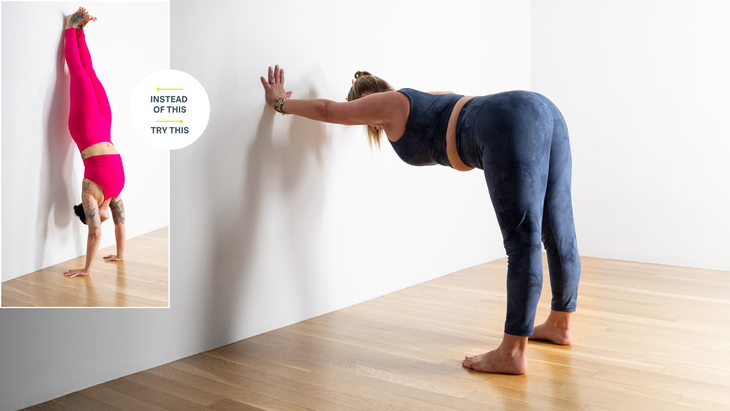
Instead of Adho Mukha Vrksasana (Handstand or Downward-Facing Tree Pose)
To mimic the body position of Handstand, practice (Tadasana) Mountain Pose with your arms extended overhead. “Reach up but pull your shoulders down at the same time,” Moore suggests. Get tall by finding the extension in your spine, as you move your shoulders away from your ears. Flex your hands as if you were pushing against the ceiling.
Alternatively, you can practice Ardh Uttanasana (Half Standing Forward Bend) at the wall (shown above). From Mountain, hinge at your hips, folding halfway and keeping your abs engaged and your spine long. Then reach your arms forward, holding them level with your ears, so that your arms and torso are parallel with the floor. Flex your wrists and press your palms firmly against the wall to get the sensation of Handstand: the spinal extension, the opening of your shoulders, and the strengthening of your abs and torso.
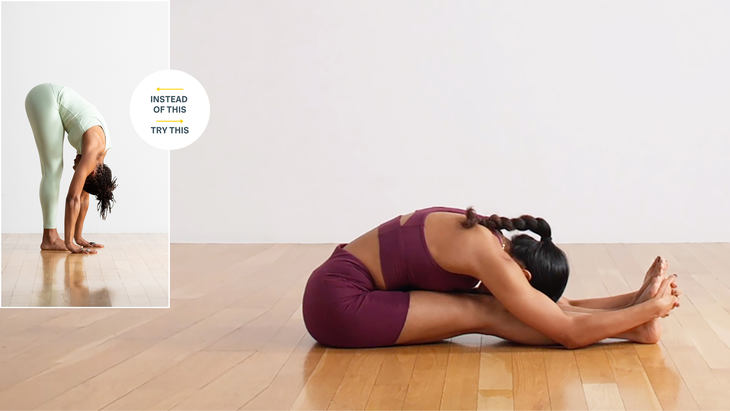
Instead of Uttanasana (Standing Forward Bend)
Standing Forward Bend stretches the entire back of your body–calves, hamstrings, glutes, and back. The weight of your head and body hanging down can give you the feeling of traction, or decompression, in your spine and neck. You can get similar stretching benefits from Paschimottanasana (Seated Forward Bend). Although you won’t have gravity pulling your spine down vertically, you are able to get a strong stretch along your back and gravity can help you fold forward.
Moore says she offers the option to practice Standing Forward Fold facing a chair. Hinge at the hips into a flat-back position and rest your hands on the seat of the chair. Keep length along your spine from your tailbone to your crown.
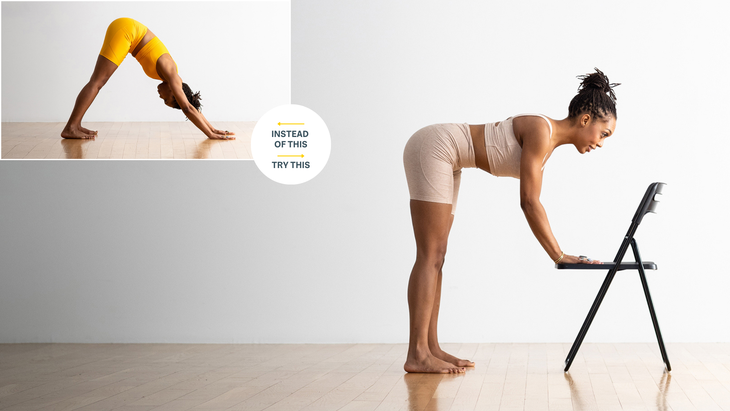
Instead of Ardha Mukha Svanasana (Downward-Facing Dog Pose)
Down Dog is incorporated into so many yoga sequences because it offers a stretch to your calves and hamstrings, opening for your back, and strength to your arms and shoulders. It is also often used as a transition pose to get you from the front of your mat to the back, or from standing to seated poses. You can use Tabletop, or hands and knees, to transition from one pose to another. Be sure to press your hands against the floor, especially through your first fingers and thumbs, and draw your shoulder blades away from your ears and away from each other to mimic the shoulder-strengthening element of Down Dog.
If students want a stretch that’s similar to the Downward Dog, they can practice it facing a chair as well. “I would have them adjust the position of their legs,” Moore says. “They can step back or move the chair forward a little so that they can get the stretch in the hamstring.”

Instead of Pincha Mayurasana (Feathered Peacock Pose)
This elegant Forearm Balance relies on stable shoulders and the ability to find equilibrium and balance in the pose. You can practice it with a deeply arched back, or as an inverted split. Try Forearm Plank to mimic the position of the pose. Or come to a Half Standing Forward Bend with your forearms against the wall, for the shoulder-opening element of the pose. A gentle Ustrasana (Camel), Dhanurasana (Bow Pose), Urdhva Mukha Svanasana (Upward-Facing Dog Pose), or Bhujangasana (Cobra Pose), may give you the back bend you are looking for. And practice Hanumanasana (Monkey Pose) to get the hip-flexor stretch that you receive in the Pincha Mayurasana split.

Instead of Bakasana (Crane Pose)…
Crane, and its sibling Crow, may not be the first pose you think of when someone says inversion, but they are definitely a head-down, hips-up posture. You can flip your Crow and practice it on your back as a variation of Ananda Balasana (Happy Baby Pose). Reach forward and bring your arms on the inside of your knees and pull your knees close to your body. Also Practice Paripurna Navasana (Boat Pose) to develop the core strength you would exercise in Crow.
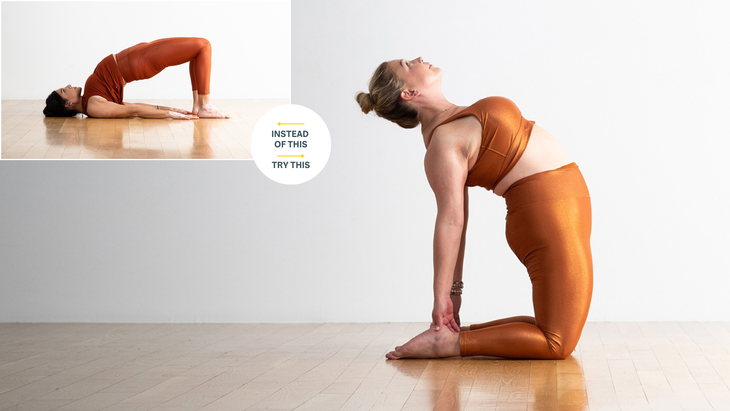
Instead of Setu Bandha Sarvangasana (Bridge Pose)…
Bridge is a less severe inversion that stretches your quads and the front of your body, but even a Half Bridge puts your head below your hips. To find the backbend and quad stretch that Bridge provides, practice Camel Pose, Upward Facing Dog, or Cobra.
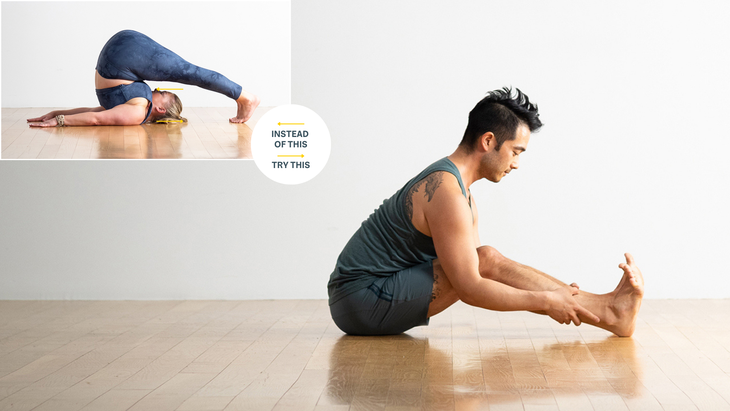
Instead of Halasana (Plow Pose)
Plow stretches your lower back as well as your glutes and legs, by taking your legs up and back over your head. A Seated Forward Bend will stretch the entire back of your body in a similar way. Wide-Angle Seated Forward Bend may allow you to go deeper into the fold, but also allows you to feel a stretch in the hip flexors and mobility in the hips.

